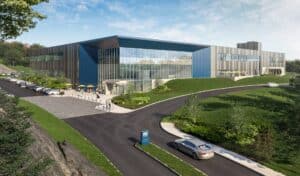
Moderna’s recent $91 million acquisition of 149 Hayes Memorial Drive in Marlborough, a newly-completed cGMP facility by Oxford Properties Group, reflects the potential for expansion of biomanufacturing close to Massachusetts’ life science cluster. Image courtesy of CNW Group and Oxford Properties Group
The push to manufacture more goods domestically spurred what some herald as the latest “Massachusetts Miracle” connected to the life science boom: biomanufacturing.
This practice of manufacturing pharmaceuticals and therapeutics is a shot in the arm for the region’s industrial market at a time when the overall commercial real estate sector rattled with uncertainty over remote work and tanked office demand.
Last summer, brokerage Newmark reported there were 2 million square feet of tenant requirements for biomanufacturing in Greater Boston, prompting a growing list of developers to focus on the emerging asset class.
Today, it’s closer to 1 million square feet of requirements. Is the sky falling on yet another commercial real estate category? Not quite, experts say.
“Some tenants have landed, and then some maybe didn’t materialize in the way that we thought. But we’re still seeing demand,” said Elizabeth Berthelette, head of Northeast research and national life science research at Newmark. “These life science companies want to have the manufacturing component close to where the [research and development] is happening.”
Notable large-scale biomanufacturing projects now underway or recently completed include a 110,000-square-foot facility in Bedford, where Ultragenyx Pharmaceutical plans to manufacture gene therapies for various inherited diseases. Chinese life science firm WuXi Biologics is expected to open a nearly 200,000-square-foot biomanufacturing facility on the site of the former Worcester State Hospital next year. And Moderna acquired a 140,000-square-foot biomanufacturing facility developed by Oxford Property Group in Marlborough earlier this year, and is expected to take occupancy in 2024 following a $322 million buildout.
But there’s no denying new groundbreakings are slowing down, and new project announcements aren’t rolling out like they were last year. Reflecting conditions throughout the broader real estate sector, high interest rates and a different funding climate are to blame.
“Most of these biotech companies rely on venture capital funding, [National Institutes of Health] grants and IPOs – and all that has dropped off pretty severely, at least relative to their frenzied highs,” said Mark Fallon, director of research and strategy at brokerage Hunneman in Boston. “That’s where we’re seeing this little bifurcation where, it’s certainly not a disaster by any means or a serious cause for concern, it’s just that there are a lot of these companies who had these growth profiles imagined in a dramatically different financing climate, and now that those profiles have changed, that has caused their outlook to change and where they can look to expand.”

Galaxy Life Sciences spent $4 million on development sites next to Worcester’s Reactory biomanufacturing project this spring for a clinical manufacturing facility. Image courtesy of Galaxy Life Sciences
Some Spec Projects on Hold
By no means should the slowdown in biomanufacturing demand be lumped into the same category as challenges in the class B office sector, Fallon added. Further, there are signs the region’s robust life science sector and the companies that lead it continue to follow a strategy of wanting to manufacture products closer to their R&D facilities.
Boston-based Berkeley Investments plans to erect a 203,000-square-foot biomanufacturing facility in Billerica. The Berkeley Investments team has held preliminary conversations with potential tenants, but is also considering moving forward on the project on a speculative basis.
“We see this as both a near-term and longer-term play as an asset class. It’s just the beginning because, as we’ve seen, the life science industry in general develops more and more drugs regionally,” said Morgan Pierson, senior vice president of development at Berkeley Investments. “Our expectation is – and I think the data is there – that they will start manufacturing locally.”
HYM Investment Group, the developer behind the nearly 17 million-square-foot redevelopment of Suffolk Downs, announced plans last year to move forward on speculation with a $280 million, 280,000-square-foot life science and biomanufacturing facility. While that project is now on pause, the development team maintains an optimistic outlook on the future of biomanufacturing in Massachusetts.
“Being close to [Boston] Logan International Airport is a really important advantage for us,” said Thomas O’Brien, CEO and founding partner of HYM, before commenting on the broader national competition for biomanufacturing jobs. “Like anything, we have to compete all the time. I think [Gov. Maura Healey] and [Lt. Gov. Kim Driscoll] recognize that North Carolina would love to have these jobs, New York would love these jobs and so would California. So, we have to compete.”
But those interviewed for this story all pointed to the strong data backing their outlook that biomanufacturing is still very much a durable real estate asset class for the Bay State.
The number of biomanufacturing jobs in Massachusetts grew by more than 25 percent in three years: From 8,394 in 2019 to 10,493 at the end of last year, according to the Massachusetts Biotechnology Council. Worcester and Middlesex Counties accounted for the greatest share of the job growth.
The overall Massachusetts life science job sector is expected to grow by 32 percent, or nearly 42,000 jobs, by 2032, according to Massachusetts Biotechnology Education Foundation report.
“This isn’t like it’s 2001 and the dot-com bubble burst,” Fallon said. “Health care is going to be one of the most dominant industries for the foreseeable future, and Boston will continue to lead the way.”






